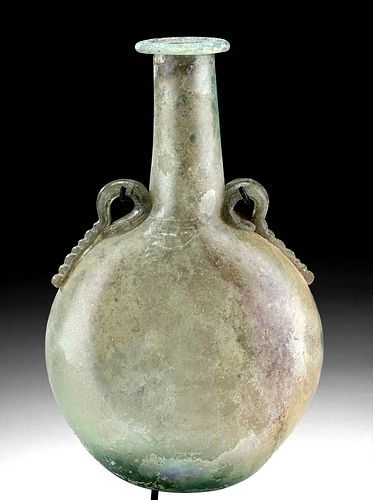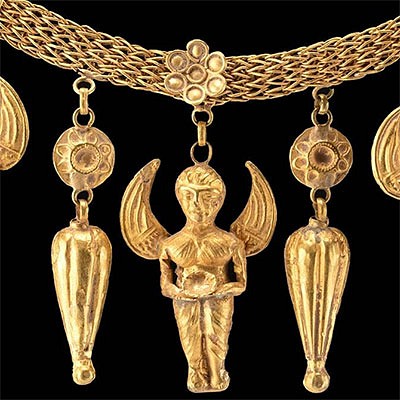Roman Glass Lentoid / Pilgrim Flask
Lot 30
About Seller
Artemis Fine Arts
686 S Taylor Ave, Ste 106
Louisville, CO 80027
United States
Selling antiquities, ancient and ethnographic art online since 1993, Artemis Gallery specializes in Classical Antiquities (Egyptian, Greek, Roman, Near Eastern), Asian, Pre-Columbian, African / Tribal / Oceanographic art. Our extensive inventory includes pottery, stone, metal, wood, glass and textil...Read more
Categories
Estimate:
$1,000 - $1,500
Absentee vs Live bid
Two ways to bid:
- Leave a max absentee bid and the platform will bid on your behalf up to your maximum bid during the live auction.
- Bid live during the auction and your bids will be submitted real-time to the auctioneer.
Bid Increments
| Price | Bid Increment |
|---|---|
| $0 | $25 |
| $300 | $50 |
| $1,000 | $100 |
| $2,000 | $250 |
| $5,000 | $500 |
| $10,000 | $1,000 |
| $20,000 | $2,500 |
| $50,000 | $5,000 |
| $100,000 | $10,000 |
| $200,000 | $20,000 |
About Auction
By Artemis Fine Arts
Dec 3, 2020
Set Reminder
2020-12-03 10:00:00
2020-12-03 10:00:00
America/New_York
Bidsquare
Bidsquare : Fine Antiquities, Ethnographic & Fine Art
https://www.bidsquare.com/auctions/artemis-gallery/fine-antiquities-ethnographic-fine-art-6119
Features classical antiquities, ancient and ethnographic art from cultures encompassing the globe. Egyptian, Greek, Roman, Etruscan, Near Eastern, Asian, Pre-Columbian, Native American, African / Tribal, Oceanic, Spanish Colonial, Russian, Fine Art, so much more! All legally acquired, legal to sell. Artemis Fine Arts info@artemisgallery.com
Features classical antiquities, ancient and ethnographic art from cultures encompassing the globe. Egyptian, Greek, Roman, Etruscan, Near Eastern, Asian, Pre-Columbian, Native American, African / Tribal, Oceanic, Spanish Colonial, Russian, Fine Art, so much more! All legally acquired, legal to sell. Artemis Fine Arts info@artemisgallery.com
- Lot Description
Roman, Eastern Mediterranean, Imperial Period, ca. 1st to 3rd century CE. A gorgeous example of a lentoid flask, oftentimes known as a pilgrim flask, that is free-blown from translucent glass of a soft green hue. The spherical body is slightly compressed and has a smooth pontil scar on the base while a pair of applied trail handles course up the shoulders and terminate in petite suspension loops. The cylindrical neck is surmounted by a splayed rim with an in-folded lip that create a delicate presentation. Soft layers of rainbow-hued iridescence have formed across the vessel and elegantly complement its pale spring color. Size: 4.1" W x 6.6" H (10.4 cm x 16.8 cm); 7.875" H (20 cm) on included custom stand.
Cf. “Solid Liquid: Greek, Roman, Byzantine and Islamic Glass.” Fortuna Fine Art, Ltd., New York, 1999, p. 102, fig. 186.
Provenance: private New York, New York, USA collection; ex-private prominent Daryl Gruber Kulok collection, New York, USA, acquired in the 2000s - Daryl Gruber Kulok (1960-2019) had homes in New York city and Connecticut and was fascinated with archaeology of the holy land. In America, she was on the philanthropic board of the Lila Gruber Research Foundation. Later in her life, she spent a good deal of time in Jerusalem where she was on the board of the American Friends of the Bible Lands, and was a serious collector of ancient art and artifacts. She was a student of biblical archaeology, and dedicated to supporting causes related to Israel. She was a major benefactor the Bible Lands Museum in Jerusalem, an institution "where people of all faiths are welcome to learn and understand our shared history." She was the key contributor to "Three Faces of Monotheism," a major exhibition there in 2007 which explored shared themes between Judaism, Christianity and Islam. Many of the pieces she donated are part of the Bible Lands Museum permanent collection.
All items legal to buy/sell under U.S. Statute covering cultural patrimony Code 2600, CHAPTER 14, and are guaranteed to be as described or your money back.
A Certificate of Authenticity will accompany all winning bids.
We ship worldwide and handle all shipping in-house for your convenience.
#159290Repairs to both handles, with very light adhesive residue along break lines that make the repairs nearly invisible and unobtrusive to the overall presentation. One indentation to backside of body created during formative process, with light weathering film, and micro-bubbling within glass matrix. Smooth pontil mark on underside of base. A pontil scar or mark indicates that a vessel was free-blown, while the absence of such a mark suggests that the work was either mold-blown or that the mark was intentionally smoothed away or wore away over time. Beautiful iridescence across all surfaces.Condition
- Shipping Info
-
All shipping is handled in-house for your convenience. Your invoice from Artemis Gallery will include shipping calculation instructions. If in doubt, please inquire BEFORE bidding for estimated shipping costs for individual items.
-
- Buyer's Premium



 EUR
EUR CAD
CAD AUD
AUD GBP
GBP MXN
MXN HKD
HKD CNY
CNY MYR
MYR SEK
SEK SGD
SGD CHF
CHF THB
THB
















